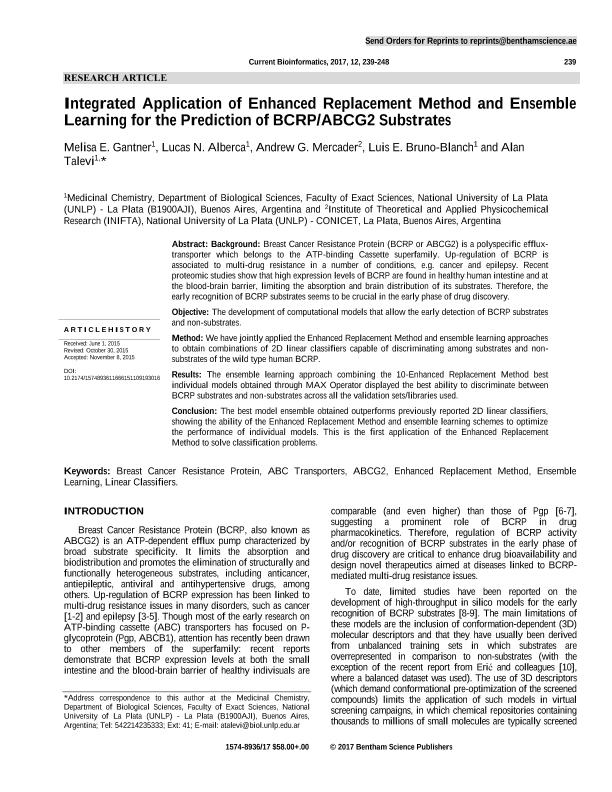Mostrar el registro sencillo del ítem
dc.contributor.author
Gantner, Melisa Edith

dc.contributor.author
Alberca, Lucas Nicolás

dc.contributor.author
Mercader, Andrew Gustavo

dc.contributor.author
Bruno Blanch, Luis Enrique

dc.contributor.author
Talevi, Alan

dc.date.available
2018-08-22T16:28:43Z
dc.date.issued
2017-06
dc.identifier.citation
Gantner, Melisa Edith; Alberca, Lucas Nicolás; Mercader, Andrew Gustavo; Bruno Blanch, Luis Enrique; Talevi, Alan; Integrated application of enhanced replacement method and ensemble learning for the prediction of BCRP/ABCG2 substrates; Bentham Science Publishers; Current Bioinformatics; 12; 3; 6-2017; 239-248
dc.identifier.issn
1574-8936
dc.identifier.uri
http://hdl.handle.net/11336/56547
dc.description.abstract
Background: Breast Cancer Resistance Protein (BCRP or ABCG2) is a polyspecific efflux transporter which belongs to the ATP-binding Cassette superfamily. Up-regulation of BCRP is associated to multi-drug resistance in a number of conditions, e.g. cancer and epilepsy. Recent proteomic studies show that high expression levels of BCRP are found in healthy human intestine and at the blood-brain barrier, limiting the absorption and brain distribution of its substrates. Therefore, the early recognition of BCRP substrates seems to be crucial in the early phase of drug discovery. Objective: The development of computational models that allow the early detection of BCRP substrates and non-substrates. Method: We have jointly applied the Enhanced Replacement Method and ensemble learning approaches to obtain combinations of 2D linear classifiers capable of discriminating among substrates and nonsubstrates of the wild type human BCRP. Results: The ensemble learning approach combining the 10-Enhanced Replacement Method best individual models obtained through MAX Operator displayed the best ability to discriminate between BCRP substrates and non-substrates across all the validation sets/libraries used. Conclusion: The best model ensemble obtained outperforms previously reported 2D linear classifiers, showing the ability of the Enhanced Replacement Method and ensemble learning schemes to optimize the performance of individual models. This is the first application of the Enhanced Replacement Method to solve classification problems.
dc.format
application/pdf
dc.language.iso
eng
dc.publisher
Bentham Science Publishers

dc.rights
info:eu-repo/semantics/openAccess
dc.rights.uri
https://creativecommons.org/licenses/by-nc-sa/2.5/ar/
dc.subject
Abc Transporters
dc.subject
Abcg2
dc.subject
Breast Cancer Resistance Protein
dc.subject
Enhanced Replacement Method
dc.subject
Ensemble Learning
dc.subject
Linear Classifiers
dc.subject.classification
Otras Ciencias Químicas

dc.subject.classification
Ciencias Químicas

dc.subject.classification
CIENCIAS NATURALES Y EXACTAS

dc.title
Integrated application of enhanced replacement method and ensemble learning for the prediction of BCRP/ABCG2 substrates
dc.type
info:eu-repo/semantics/article
dc.type
info:ar-repo/semantics/artículo
dc.type
info:eu-repo/semantics/publishedVersion
dc.date.updated
2018-08-21T18:37:09Z
dc.journal.volume
12
dc.journal.number
3
dc.journal.pagination
239-248
dc.journal.pais
Estados Unidos

dc.journal.ciudad
Oak Park
dc.description.fil
Fil: Gantner, Melisa Edith. Universidad Nacional de La Plata. Facultad de Ciencias Exactas. Departamento de Ciencias Biológicas. Cátedra de Química Medicinal; Argentina. Consejo Nacional de Investigaciones Científicas y Técnicas; Argentina
dc.description.fil
Fil: Alberca, Lucas Nicolás. Universidad Nacional de La Plata. Facultad de Ciencias Exactas. Departamento de Ciencias Biológicas. Cátedra de Química Medicinal; Argentina. Consejo Nacional de Investigaciones Científicas y Técnicas; Argentina
dc.description.fil
Fil: Mercader, Andrew Gustavo. Consejo Nacional de Investigaciones Científicas y Técnicas. Centro Científico Tecnológico Conicet - La Plata. Instituto de Investigaciones Fisicoquímicas Teóricas y Aplicadas. Universidad Nacional de La Plata. Facultad de Ciencias Exactas. Instituto de Investigaciones Fisicoquímicas Teóricas y Aplicadas; Argentina
dc.description.fil
Fil: Bruno Blanch, Luis Enrique. Universidad Nacional de La Plata. Facultad de Ciencias Exactas. Departamento de Ciencias Biológicas. Cátedra de Química Medicinal; Argentina
dc.description.fil
Fil: Talevi, Alan. Universidad Nacional de La Plata. Facultad de Ciencias Exactas. Departamento de Ciencias Biológicas. Cátedra de Química Medicinal; Argentina. Consejo Nacional de Investigaciones Científicas y Técnicas; Argentina
dc.journal.title
Current Bioinformatics

dc.relation.alternativeid
info:eu-repo/semantics/altIdentifier/doi/http://dx.doi.org/10.2174/1574893611666151109193016
dc.relation.alternativeid
info:eu-repo/semantics/altIdentifier/url/http://www.eurekaselect.com/node/136755/article
Archivos asociados
